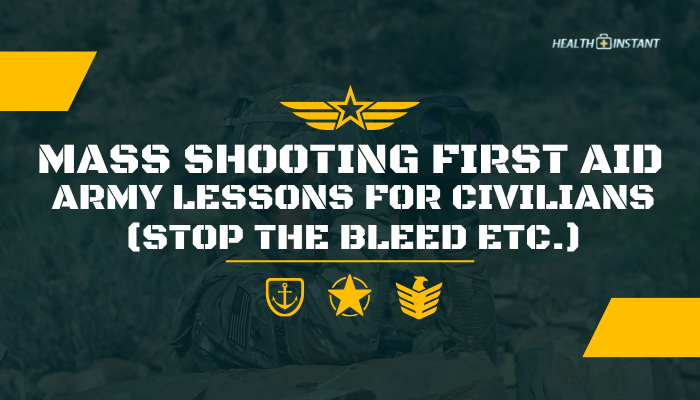Introduction
Mass shootings strike rapidly and often end before professional help arrives. In such high-risk events, the immediate steps of bystanders—particularly controlling bleeding—can determine whether victims survive.
While advanced trauma care is best left to EMS or combat medics, the military’s “tactical combat casualty care” approach has influenced civilian programs like “Stop the Bleed,” teaching everyday people how to stabilize severe injuries.
This guide outlines critical, Army-inspired first aid measures, focusing on hemorrhage control, prioritizing personal safety, and supporting professional responders.
Why Immediate Bleeding Control Matters
- High Fatality Risk: Major blood loss can lead to death in minutes.
- Time Constraints: Average EMS arrival times vary; in mass casualty incidents, delays may be even longer.
- Bystander Impact: Simple interventions like direct pressure or a tourniquet can save lives before medics reach the scene.
Stop the Bleed: A Civilian Adaptation of Army Lessons
The U.S. Army’s combat casualty care has long emphasized rapid hemorrhage control as the first life-saving step. Translating these lessons into civilian life, “Stop the Bleed” programs train volunteers to:
- Recognize arterial bleeding and life-threatening wounds.
- Quickly apply direct pressure or appropriate tourniquets.
- Pack deep wounds with gauze or cloth when pressure alone isn’t enough.
Assessing the Scene and Personal Safety
- Evaluate Threat
- Before offering help, ensure the shooter is not nearby. Take cover if danger persists.
- Call 911
- Even if you’re providing first aid, professional responders must be alerted.
- Move the Injured
- If possible and safe, move victims to a protected location to avoid further harm.
- Communicate Calmly
- Seek help from others, designate tasks, maintain overall awareness of any ongoing threats.
Identifying Life-Threatening Bleeding
Signs of severe hemorrhage:
- Pulsing or continuous blood flow from a wound.
- Blood soaking clothing quickly.
- Large pooling of blood on the ground.
- Victim appears pale, confused, or faint—signs of shock.
If blood spurts or seeps relentlessly, treat it as life-threatening arterial or venous bleeding.
Applying Tourniquets and Pressure Dressings
Tourniquet Use
- Position
- Place the tourniquet 2–3 inches above the wound, avoiding joints if possible.
- Tighten
- Twist the windlass or mechanism until bleeding stops or significantly lessens.
- Mark Time
- Write the application time on the tourniquet or the patient’s skin to guide further medical care.
Packing Wounds
- For Wounds Not Suitable for a Tourniquet (e.g., torso, groin, or neck):
- Insert gauze or cloth into the wound cavity, applying firm pressure.
- Maintain compression until bleeding slows or responders arrive.
Assisting with Airway and Breathing Issues
- Conscious Victims: Encourage them to sit upright, ensuring open airways.
- Unconscious or Not Breathing: If safe to do so, begin basic CPR or rescue breathing per your training.
- Positioning: Recovery position if the victim is unconscious but breathing, to prevent airway obstruction.
Psychological First Aid and Calming Techniques
In addition to physical care, panic can spread rapidly during mass shootings:
- Offer Reassurance: Simple phrases like “You’re going to be okay” can help.
- Active Listening: Let them express fear or pain, but remain brief and practical.
- Stay Focused: Comfort is important, but life-threatening bleeding or airway needs come first.
Coordinating with Professional Responders
When EMS or law enforcement arrive:
- Provide Clear Info
- Describe injuries, interventions taken, time of tourniquet application.
- Cooperate
- If asked to move or follow instructions, do so promptly.
- Transition
- Let paramedics handle advanced care. Do not abandon other victims still needing immediate first aid if you can assist.
Conclusion
In mass shooting events, minutes matter. Drawing from Army-based trauma care, programs like “Stop the Bleed” equip civilians to manage severe bleeding and preserve life until medical professionals step in.
While personal safety must remain a priority, learning to assess the wounded and apply direct pressure or a tourniquet can dramatically reduce fatalities.
By combining calm decision-making, proper technique, and effective communication with responders, civilians can become vital contributors to saving lives in dire circumstances.
References
- Stop the Bleed Campaign. (2021). American College of Surgeons guidelines.
- U.S. Army. (2020). Tactical Combat Casualty Care basics for bystanders.
- American Red Cross. (2019). Tips for bleeding control in mass casualty incidents.
- Federal Emergency Management Agency (FEMA). (2021). Active shooter and mass casualty preparedness.
Disclaimer: This guide is informational only, not a substitute for professional training. Always follow local laws and law enforcement instructions in an active shooter or mass casualty scenario.

